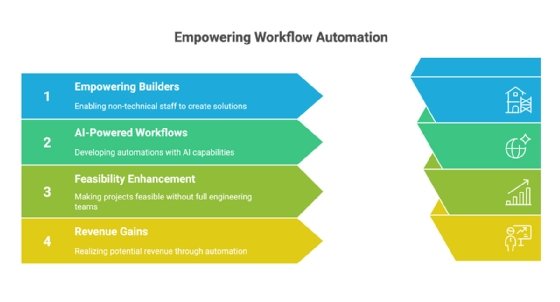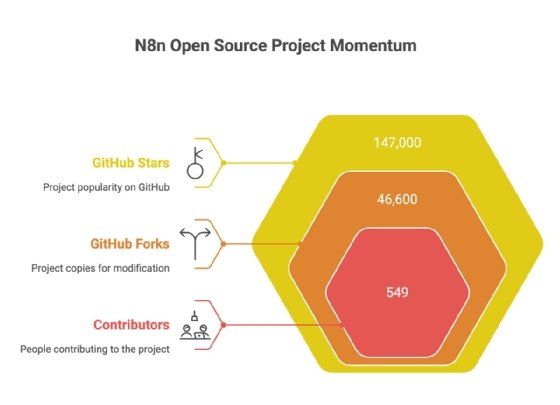
Getty Images/iStockphoto
Low-code tool n8n bridges gap between AI models and business
Many organizations struggle to realize AI projects. N8n aims to bridge the gap between AI engineers and business users, empowering non-technical staff to build AI workflows.
Low-code automation tools aim to make enterprise-grade workflow automation more accessible for business users.
In a press release announcing a $180 million Series C funding round on Thursday, workflow automation and integration tool developer n8n makes a salient point about the value of automation tools:
"This investment recognizes something fundamental: the AI race isn't only about smarter models -- it's about who can actually put that intelligence to work reliably, inside actual businesses."
Today, we have a great lineup of AI models, each one of them more than good enough for driving the automation of a wide range of business tasks. What enterprises are lacking is a reliable and efficient way of making these "more than good enough" models accessible to business users so that they can contribute to the automation of their own tasks and workflows.
AI-driven automation is often inaccessible
The breadth of impactful automation uses spans most current business processes.
For example, imagine a marketer who wants to automatically turn customer feedback into campaign ideas without spending hours sorting spreadsheets and weeding through online sources, a finance manager who wishes daily invoice checks could flag issues on their own, or an HR specialist who dreams of using a chatbot to instantly answer employee questions instead of digging through documents.
Each of these capabilities would have significant business benefits. While there is no shortage of AI models, automation platforms and AI infrastructure that can be quickly provisioned, AI initiatives are often unsuccessful due to the disconnect between data and AI experts on one side and business experts on the other. AI engineers typically do not have the time to help business staff flesh out their automation ideas. business experts typically do not have the skills or experience to identify and clearly define AI-driven workflows. This causes the majority of AI uses to be unidentified, unimplemented or unsuccessful.

Empowering the builders in the middle
Workflow automation platforms like n8n aim to fix this problem.
The n8n open-source workflow automation platform -- available as a managed service or self-managed -- helps an audience beyond just data scientists and analysts implement a wide range of AI-enhanced automation workflows. These platforms aim to empower the builders in the middle -- the ones closest to the business problems -- to create AI-powered workflows. Building these automations used to require a full engineering team, making many of them unfeasible.
The tool enables both technical and non-technical users to build sophisticated automation workflows by visually connecting APIs, databases and AI-models through a node-based interface.
Multiply the number of unrealized automation projects by the number of staff hours and potential revenue gains these automations could have brought, and the product is the value that a platform such as n8n can bring to an organization.

User momentum and industry buy-in
147,000 GitHub stars, 46,600 forks and 549 total contributors are a strong testament to the momentum of the n8n platform. During the first week of October, 53 authors pushed 474 code commits on GitHub. Another indicator of n8n's momentum is the 6,035 mostly user-created workflow automation templates and more than 1,000 integrations that are either freely accessible or can be downloaded for a nominal fee.
Users can implement pre-configured AI agents from all major vendors -- such as OpenAI, Anthropic, Google and Azure -- to perform data analyses, enrichment or transformation. Once a user has gotten into the automation groove, they can significantly contribute to improving business processes without requiring large upfront budgets and time commitment. This instills an automation culture into the enterprise that often compounds with each new project.

Closing the gap between developers and business users
Automation and integration tools such as n8n also offer the ability to orchestrate code written in JavaScript or Python, giving users access to modern data science libraries such as pandas, matplotlib and spaCy. Users can then add these custom programs to workflows. Some examples of this capability include:
- Data enrichment and cleansing. A marketing analyst could run a short Python script using pandas to clean and enrich lead data before it's pushed into the CRM, ensuring campaigns target the right audience.
- Text analysis for customer feedback. A product manager might embed a spaCy routine in an n8n workflow to extract sentiment from open-ended survey responses, automatically routing urgent feedback to support.
- Custom data visualization. A finance specialist could use matplotlib inside of an n8n workflow to generate weekly revenue trend charts and automatically email them to stakeholders as images -- no manual Excel work needed.
Overall market assessment
Among its peers, n8n stands out because of its workflow automation features and application integrations with user-friendly access to advanced AI. Unlike typical low-code AI tools, n8n offers extensive control over every aspect of a workflow, which is crucial for compliance and accuracy. This detailed control also simplifies the adoption and enhancement of community or internal workflows, making them safer and easier to integrate.
With an intuitive UI, helpful wizards, an AI assistant and clear error messages, n8n enables users with even basic technology affinity to build valuable automations. This fosters a culture of automation thinking, encouraging everyone in the business to identify and automate repetitive tasks. This creates value that the business will retain independently of individual staff.
N8n occupies a strategic position in the automation landscape, competing with two distinct categories of platforms. On one side are business-focused integration platforms like Zapier, Make and Boomi that prioritize ease of use and extensive pre-built connectors. On the other side are developer-centric solutions such as Apache Airflow, StackStorm and Node-RED that offer deeper technical control and specialized capabilities. Unlike most integration platforms that operate exclusively as closed-source SaaS offerings, n8n provides both cloud and self-hosted options through its open-source codebase on GitHub, enabling a vibrant community ecosystem that proprietary platforms struggle to cultivate.
Business integration platforms
The business integration platforms excel in breadth and accessibility. Zapier leads with more than 6,000 integrations, while Make offers more than 1,500, compared to n8n's 1,183, making these platforms superior choices when connecting to niche or obscure SaaS products. More importantly, these platforms optimize for non-technical users -- Zapier's linear interface enables complete beginners to create automations within minutes, whereas n8n's node-based approach demands understanding of workflow concepts and visual programming paradigms. This accessibility gap represents a fundamental trade-off: simplicity versus customizability.
Developer-focused platforms
Against developer-focused platforms, n8n faces different challenges centered on technical depth rather than breadth. Apache Airflow's directed acyclic graph-based architecture provides sophisticated scheduling and dependency management that data engineering teams require, plus native Python access to libraries such as pandas and scikit-learn without wrapper nodes. StackStorm's event-driven architecture and millisecond reaction times make it superior for infrastructure automation and incident response. Node-RED, despite sharing n8n's visual approach, includes built-in real-time data monitoring and dashboard capabilities, whereas n8n requires external tools such as ObservableHQ for visualization. Each specialized platform excels in its domain -- batch processing, event response or IoT respectively -- while n8n attempts to bridge all these uses with inevitable compromises.
The n8n approach
N8n offers a solid compromise between the simpler API integration platforms on the one hand and the more complex and therefore developer-focused orchestration tools on the other. It provides enough visual simplicity to onboard technical business users who would struggle with Airflow's Python-first approach, while offering sufficient depth through custom code nodes and self-hosting options to satisfy developers who find Zapier's limitations frustrating. This middle ground makes n8n particularly valuable for growing organizations that need more than basic trigger-action automation but aren't ready to commit engineering resources to maintaining enterprise-grade orchestration infrastructure. The platform's open-source nature and workflow-based pricing model enable teams to start simple and scale complexity without the exponential cost increases or platform migrations that typically accompany growth in the automation space
The funding comes at the right time. Many organizations have gone through sobering experiences with at least some of their initial AI projects, partially due to a disconnect between AI engineers and business users. The n8n platform directly addresses this challenge and now has $180 million in its war chest to expand its open-source community, deepen integrations, and enhance collaboration, compliance, governance and security capabilities -- positioning itself as the go-to platform for democratizing AI-powered workflow automation across modern enterprises.
Torsten Volk is principal analyst at Enterprise Strategy Group, now part of Omdia, covering application modernization, cloud-native applications, DevOps, hybrid cloud and observability.
Enterprise Strategy Group is part of Omdia. Its analysts have business relationships with technology providers.







